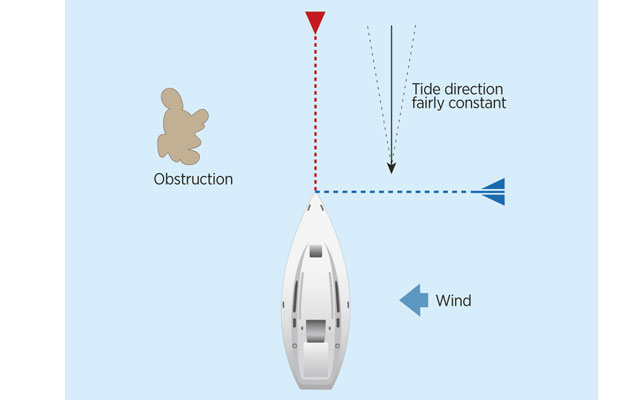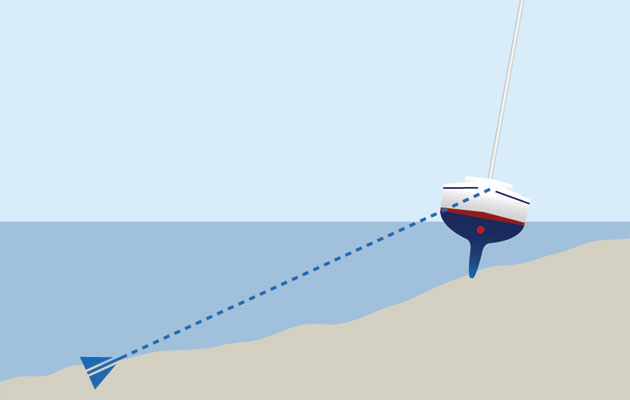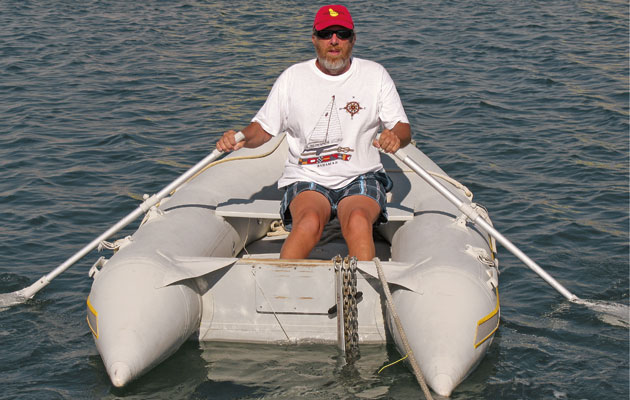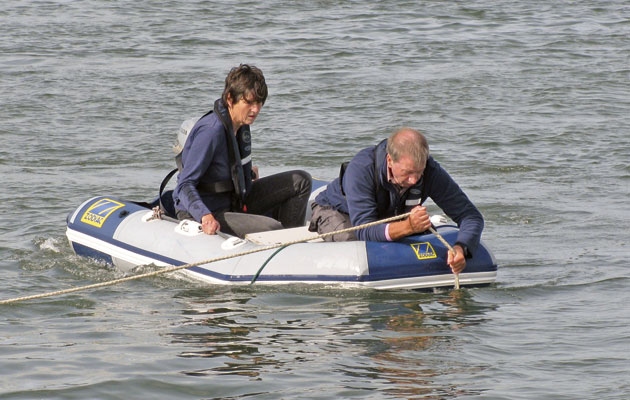Is your kedge anchor lying forgotten in its locker? Vyv Cox outlines 8 ways you can put it to good use
8 uses for a kedge anchor
Most yachts carry more than one anchor. The main, or bower anchor, is usually carried on the bow roller or in an anchor locker and used for general anchoring. The kedge anchor, meanwhile, is often seen as a spare, left in a locker, unused and unloved.

Vyv Cox is a retired metallurgist who spends six months a year in the Mediterranean living onboard his Sadler 34, mostly at anchor
Yet a kedge can be extremely useful, offering a wide variety of applications, both for everyday use and when things go wrong:
- Owners of boats without a windlass to retrieve the considerable weight of the bower and its chain will use a kedge for brief stops, such as lunchtime stop-overs. The effort involved in recovery is lessened considerably.
- Approaching an anchorage, you realise three or four boats are already there, leaving you only a small space with a rocky reef on one side and shallows on the other. There is barely room to swing between the two obstructions and you know the situation will worsen at low tide. The next anchorage is more than two hours away. What should you do? The answer is to use the kedge anchor to hold your boat firmly where you want it, while you relax.
- After taking shelter in a bay, the forecast begins to promise southwesterly Force 7-8 winds. The holding doesn’t seem that good. The boat is swinging around through large angles, taking gusts on the beam that heel her to 20 degrees or more. A few of your neighbours have already dragged. Once again the kedge can be your friend, calming the yawing and helping to ensure that your anchor remains exactly where you want it.
- Narrow bays and channels

Vyv’s Sadler 34 in a narrow cala on the east coast of Mallorca. Swinging room here was almost non-existent
Attach the warp to an aft cleat. Works well in narrow bays, rivers and channels where there is little tide, or where it reverses 180°. It will hold the boat on a line between the anchors, useful where the edges of the channel are shallow or where the boat might hit rocks or other obstacles on the channel edge. Note that the stern of the boat will face the current when the tide turns and the rudder must be fixed accordingly.

The simplest use of a kedge is to prevent a yacht swinging into an obstructionor shallows should the tide or wind change direction
Beware, too, of side winds, which can create unfair loading on one or both anchors and cause dragging. In a restricted anchorage it may be necessary to move the kedge into an upwind position, as in the Side Kedge technique (see method 3).
- Reversing current
The boat is free to pivot from the bow. Ideal in a narrow anchorage with reversing current/tide, such as a river. When wind strength is greater, it is more secure than the simple method, although limited by the unfair force on the anchors
An alternative to method 1, this is particularly useful in a reversing current, such as a river or estuary, where swinging must be limited. It’s also better than simple fore-and-aft if there is some cross-wind. Both the bower and the kedge rodes are attached to the bow roller via a shackle set below keel depth.

The boat is free to pivot from the bow. Ideal in a narrow anchorage with a reversing current/tide, such as a river. When the wind strength is greater, it is more secure than the simple method, although limited by the unfair force on the anchors
After anchoring the boat by the bower, the chain is run out to about twice the length required for the maximum water depth. The kedge is placed here and the boat moved back to its original position while hauling in the chain. Here a shackle is attached to the chain after threading the kedge warp through it, allowing both rodes to be led to the bow roller. The chain is then run back out about two metres and the kedge warp hauled in until tight. The beauty of this method is that the bow of the boat will always face upstream, unlike with simple fore-and-aft.
- Avoiding an obstruction
Suitable when there is an obstruction to one side that must be avoided and the wind and tide directions are likely to remain constant while at anchor. In this case the kedge is used to one side – taken to the bow or perhaps to a centre cleat – limiting swinging in the opposite direction.
- Better holding in strong winds

The fork moor will calm the motion of the boat and help prevent the breakout of either anchor. Useful when winds are gusting above 30 knots
This can be used when anchoring in strong winds coming from a fairly constant direction. Laid at an angle of around 60-90 degrees to the bower, a second anchor reduces yawing to a remarkable extent. A boat sheltering from a gale in an anchorage surrounded by cliffs can be subjected to savage gusts from many different directions. Not only is this uncomfortable, but the constant ‘sailing around the anchor’ works at the bower, risking the chance of it breaking out. The addition of the kedge can reduce the angle of yawing by as much as 50%, helping prevent drag and anchor break-out, and making life far more comfortable. The main disadvantage is that the kedge warp can become tangled in the bower chain if the wind direction changes, so it must be moved or recovered in good time. Constant attention to the wind’s direction is required with this technique.
- Veering winds

If you’re expecting a front to come through, you can set an anchor that will keep you safe in the new breeze
This method can be extended to take account of an unexpected veer in wind direction, such as during the passing of a cold front. The kedge is laid out towards the expected wind direction in order to avoid contact with an obstruction after the veer has taken place.
- Differing wind and waves

Some experimentation is needed to find the point at which stable rotation of the boat occurs. Snatch blocks and lines are ideal for the job. A point close to the centre cleat will usually be best
Another variation of the fork moor can be used in that most annoying of situations where the wind and waves are coming from different directions, with the result that the boat rolls to the waves while lying to the wind.
The kedge can be laid off to the wave direction and hauled in on the centre cleat, rotating the boat to face the incoming waves, thus promoting far more comfortable pitching.
- Hauling off with the kedge
This technique has been used since the dawn of sailing. If the yacht is aground, the kedge is laid out into deeper water, into which you can attempt to haul the yacht using genoa winches.
- When high and dry
Similarly, where the yacht is high and dry, the kedge can be laid out in the direction of the new flood, again choosing a lower ground level, channel or pool, to prevent the yacht moving back to shallow water on the rising tide
What equipment do I need?
The main requirements for any kedge are that it should be easily handled and stowed. It needs to set quickly and have powerful holding, usually for a sustained pull in one direction only. This job description suits ‘flat’ anchors very well, with the result that Fortress, Danforth, FOB and other similar anchors hold pride of place in the kedge field. Their surface area is high for their weight, remembering always that anchors are sold by weight rather than hold area. In many cases an old anchor that has been superseded by a newer one is relegated to the kedge position but it must be said that Bruce, CQR and their various clones are far from ideal for the purpose.

The recommended size for a kedge anchor is usually one level lower than for the bower, although my choice was to select the one recommended for my boat length and longer
Warp
Multiplait nylon is the best for this job. Its remarkable resistance to tangling is of inestimable value when trying to row out a kedge singlehanded in 30 knots of wind. Braid-on-braid nylon is almost as good, whereas simple three-strand nylon comes a very poor third, as it both tangles and hardens on exposure to seawater. Again, the size need not be as large as might be used for a bower anchor warp.
Chain
It is usual to connect five to seven metres of chain to the kedge anchor, to help it set and take the brunt of wear against sand and rocks on the seabed. The chain need not be as large as that for the bower, one size down being widely quoted, although again, mine is the same size as the bower.
Stowage and use
The kedge and its warp need to be ready for instant use. Ideally, the anchor will be mounted externally to the boat, on the pushpit or elsewhere on the stern. If stowed in a stern locker, make sure it does not become overloaded with other kit.
Many methods are used to stow the warp. Perhaps the ideal is to have a small locker below the aft deck, with the warp feeding through a hawse pipe and over a roller. Buckets attached to the pushpit are widely seen on charter and liveaboard boats, often with the anchor in the same receptacle. Buckets and bags that will stow inside a stern locker are a reasonable alternative if pushpit size allows nothing better.
How to lay a kedge anchor
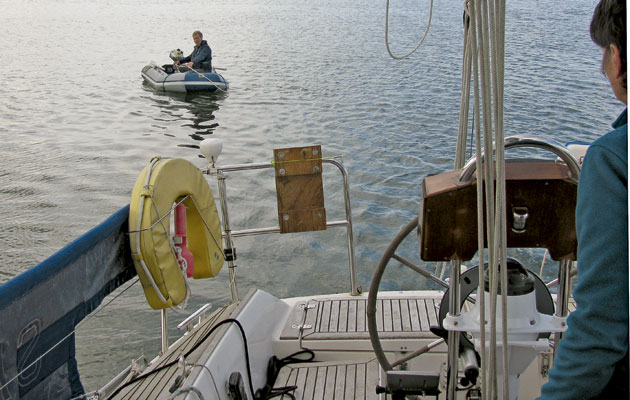
Once the anchor is down, the warp should be hauled in hard by someone on the yacht to set it properly
There are two main ways in which a kedge can be laid – either from the dinghy or from the yacht itself.
Be aware that if you are using a kedge but other boats anchored around you are not, there is a risk of collision. You need to ensure they won’t swing into you if the wind direction changes.
Bear in mind, too, that ‘flat’ anchors have a particularly undesirable feature, which is that they can be fouled by their own chain. With a reverse or sideways pull, the chain can get stuck between the flukes and stock. Make sure you launch the anchor carefully and check that it holds well before relying on it.
Finally, beware of chafe. A slit plastic tube, wrapped around the warp at any chafe points, will help.
Kedging from the dinghy
To avoid wrapping the warp around the prop, rowing the dinghy is preferable to using an outboard. If motoring is unavoidable, it’s better to drive astern. The kedge anchor and chain are carried in the tender.
The rope can be either fed out by a crewmember on the yacht or carried in the dinghy, once it is safely secured to the yacht. Either method works well with rope, which streams out easily. But if you have an all-chain rode, all of it must be carried and then laid out from the tender.
The simplest way to carry the anchor and chain is to place it in the stern of the dinghy with the rower’s feet on it to ensure that it is not dragged over the transom. The drawback here is that anchors are sharp and unwieldy and an inflatable dinghy may suffer damage or even a puncture.
It is far better to fit a cleat on the transom of the dinghy from which the anchor and chain can be conveniently hung. In our trials we tried cleats on both the inside and outside of the transom, finding it far easier to drop the anchor and chain from the inside cleat. Once the dinghy is in position, the rower (or assistant) should lower the anchor and chain overboard, to avoid fouling of the anchor.
Once the anchor is down, the warp should be hauled in hard by someone on the yacht, to ensure that it has set properly.
Kedging from the yacht
First, set and check the bower to windward. Then the yacht can be moved into a position where the kedge will be set. For fore-and-aft setting this will require that the bower rode be run to about twice its set length, then hauled back in to the original length.
Recovery
Recovery of the kedge anchor is generally straightforward. Sitting in an inflatable dinghy, the crew can haul themselves along the warp until the dinghy sits immediately above the anchor.
It is usually necessary to haul vertically upwards to break the kedge’s hold on the bottom – often with a good deal of force.
A steady pull on the warp for a few seconds, with the warp over the dinghy’s tube, is usually sufficient to break the anchor out.
Thanks to: Gill Kent and Joe Presford of North West Venturers Yacht Club, who are based in Beaumaris, Anglesey, for their help with this feature.
Enjoyed reading 8 uses for a kedge anchor?
A subscription to Yachting Monthly magazine costs around 40% less than the cover price.
Print and digital editions are available through Magazines Direct – where you can also find the latest deals.
YM is packed with information to help you get the most from your time on the water.
-
-
- Take your seamanship to the next level with tips, advice and skills from our experts
- Impartial in-depth reviews of the latest yachts and equipment
- Cruising guides to help you reach those dream destinations
-
Follow us on Facebook, Twitter and Instagram.







